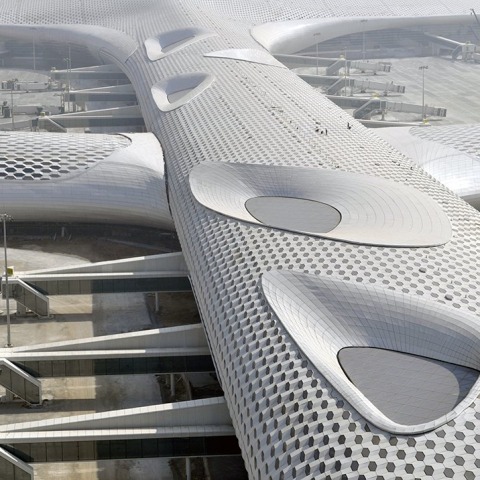Abaout project by Fuksas architects
The terminal – the largest single public building to be built to date in Shenzhen - encompasses 63 contact gates, with a further 15 remote gates and significant retail space. It will increase the capacity of the airport by 58%, allowing the airport to handle up to 45 million passengers per year.
The sculptural 500,000 sq.m. / 5,381,955 sq.ft (approx.) terminal, evokes the image of a manta ray and features a striking internal and external double ‘skin’ honeycomb motif that wraps the structure. At 1.5 km long, with roof spans of up to 80m, honeycomb shaped metal and glass panels punctuate the façade of the terminal allowing natural light to filter through. On the interior, the terminal is characterized by distinctive white conical supporting columns that rise to touch the roof at a cathedral-like scale.
The focal point of the design is the concourse located at the intersection of the building. Consisting of three levels – departure, arrivals and services – they vertically connect to create full height voids, allowing natural light to filter from the highest level down to the lowest.
Studio Fuksas has created an interior, as striking and elegant as the exterior. The spatial concept is one of fluidity and combines two different ideas: the idea of movement and the idea of pause. Carefully considering the human experience of such environments, Studio Fuksas focused on processing times, walking distances, ease of orientation, crowding, and availability of desired amenities.
Stand-out features of the interior design include stylized white ‘trees’ that serve as air conditioning vents, and check-in ‘islands’, gates and passport-check areas with a stainless steel finish that beautifully reflect the honeycomb patterns from above. The honeycomb motif translates through into many aspects of the interior and at different scales – from the larger retail boxes to smaller 3D imprints in the wall cover.
The Studio Fuksas designed Terminal 3 is of critical importance to the future of Shenzhen as a booming business and tourist destination, and will bring benefits to the region as a whole.
Studio Fuksas are engaged on two further phases of the airport extension, scheduled to complete in 2025 and 2035 respectively.
CREDITS.-
Project.- Shenzhen Bao’an International Airport, Airport Expansion Terminal 3.
Location.- Bao’an District, Shenzhen, Guangdong, China.
Dates.- 2008 – 2013. International competition won in 2008 over finalists including Foster + Partners (UK), Foreign Office Architects (UK), Gmp International (Germany), Kisho Kurokawa (Japan), Reiser+Umemoto (USA).
Size.- 500,000 sq.m. / 5,381,955 sq.ft (approximately).
Architects.- Massimiliano and Doriana Fuksas.
Interior design.- Fuksas Design - internet-point, check-in ‘island’, security-check, gates, passport-check areas, shop box, baggage-claim ‘islands’, info-point, ventilation trees, signage, commercial desk and washrooms.
Client.- Shenzhen Airport (Group) Co., Ltd.
Developer.- Shenzhen Planning Bureau; Shenzhen Airport (Group) Co., Ltd.
Contractor.- China State Construction Engineering Corporation, Beijing.
Structures, façade and parametric design.- Knippers Helbig Engineering, Stuttgart, NY. Architect of record.- BIAD (Beijing Institute of Architectural Design), Beijing. Lighting consulting.- Speirs & Major Associates, Edinburgh, London.
Materials.- Steel with a concrete substructure. 52,000 tonnes of steel was used, with an additional 260,000 tonnes of reinforcement. It has won the ‘Steel Gold Award (National Quality Engineering)’.
Sustainability.- The design has been optimised to make best use of natural ventilation and light. Photovoltaics will meet the electricity demand of T3, making about 950 million electricity units each year. Future photovoltaic generation is expected to reach a capacity of 10MW that will be used to support the electronic devices of the entire airport.
Cost.- 734,000,000 Euros.
Orientation.- The main building includes two-storey underground and four layers above the ground (partial five storeys). The fourth floor is the departure hall. The third floor is connected with the domestic departing passengers channel and the center of it is the international joint inspection zone, luggage collection/checkpoint and the office area located on both sides. The domestic passage channel, luggage claim hall and part of the office area are on the second floor. At the north east part of the first floor is the international departure hall. Its center is used for the international joint inspection zone and also the luggage claim hall. In front of the first floor stand the CIP lounges. Between it and the main building stands the outdoor courtyard.
Via v2com
































